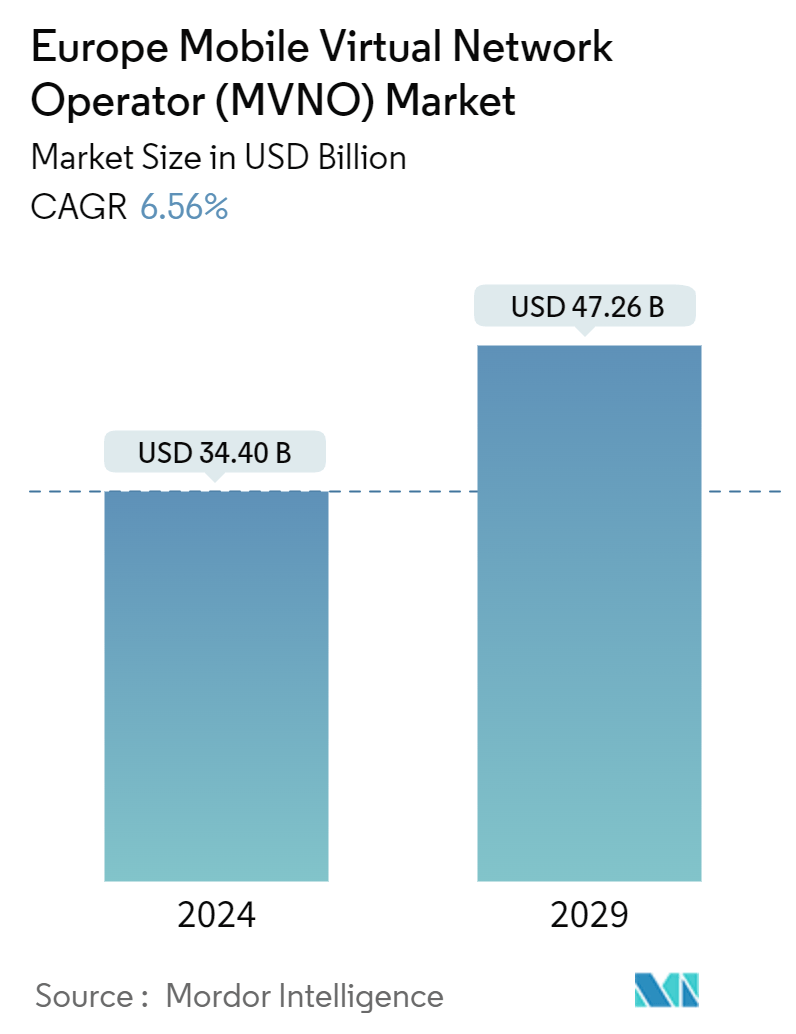Market Size of Europe Mobile Virtual Network Operator (MVNO) Industry

| Study Period | 2019 - 2029 |
| Base Year For Estimation | 2023 |
| Market Size (2024) | USD 34.40 Billion |
| Market Size (2029) | USD 47.26 Billion |
| CAGR (2024 - 2029) | 6.56 % |
| Market Concentration | Medium |
Major Players
*Disclaimer: Major Players sorted in no particular order |
Europe Mobile Virtual Network Operator (MVNO) Market Analysis
The Europe Mobile Virtual Network Operator Market size is estimated at USD 34.40 billion in 2024, and is expected to reach USD 47.26 billion by 2029, growing at a CAGR of 6.56% during the forecast period (2024-2029).
The total number of mobile virtual network operators (MVNOs) in Europe has increased, and they have significantly strengthened their presence. This growth has been mainly driven by the emergence of non-telco brand-led MVNOs entering the mobile service provider space, which boosted market growth opportunities.
- Enabled by 5G network slicing, European businesses are poised to witness a surge of MVNOs targeting specific verticals. These MVNOs are focused on building solutions that cater to specialized connectivity needs and integrate cloud services and AI/big data solutions. These emerging MVNOs empower small businesses and entrepreneurs by harnessing AI, big data, and cloud services.
- According to Ericsson, Western Europe's 5G subscribers are estimated to reach 443 million by 2028. Also, the rising adoption of services like cloud computing, machine-to-machine (M2M) transactions, and mobile money is set to boost the demand for mobile virtual network operators (MVNOs) in Europe during the forecast period.
- Advancements in network and cloud technologies, alongside the adoption of eSIMs, are reshaping the MVNO landscape, democratizing it, and broadening access. This shift is enabling not just telcos but also brands and individuals to enter the market. As MNO retail revenues surge and the imperative to capitalize on 5G investments intensifies, MVNOs are finding a more receptive network partner environment. Additionally, the rise of multi-tenant MVNE (mobile virtual network enabler) platforms is significantly simplifying the task for host MNOs in managing their MVNO tenants in the region.
- Cost-effective pricing, tailored service offerings, and a saturated mobile market propel the growth of Europe's MVNO market. Also, the advent of 4G and the ongoing 5G deployment are enhancing service quality. Established retail and media brands are leveraging MVNOs to strengthen market penetration and consumer trust. Focusing on superior customer service, innovative business models, and increased consumer awareness further solidifies MVNOs' appeal, allowing them to effectively cater to niche markets and diverse customer demands.
- Growth in e-SIM technology accelerates changing dynamics, offering European consumers enhanced convenience and flexibility. By eliminating the logistical hurdles of physical SIM cards, digital-only MVNOs can now launch faster and at significantly reduced costs. This advancement allows consumers to seamlessly switch providers, avoiding high roaming charges or gaining extra minutes and data when reaching plan limits. Consequently, MVNOs have a broader opportunity to introduce innovative offerings and attract new clientele.
- Key market players are actively forming partnerships to expand the overall reach of their innovative products across various markets, bolstering their market share. In September 2023, fliggs Mobile partnered with T-Mobile, unveiling the pioneering all-digital Web3 MVNO. This strategic move not only merged Telco and Web3 but also positioned fliggs Mobile as a pivotal player in driving widespread Web3 adoption.
- By embedding a non-custodial wallet directly into its mobile app, fliggs Mobile has provided its clientele with a seamless and safe entry point into Web3, the future of the Internet. fliggs Mobile, the significant MVNO offering a decentralized ID (DID), empowers users with universal access to Web3 and FinTech services. This grants customer heightened data control and bolsters privacy in their digital transactions. Moreover, the wallet streamlines cryptocurrency payments, introduces cashback loyalty programs, and supports charitable donations.
- However, the intense competition in Europe's MVNO market has led to price wars and minimized profit margins. MVNOs face hurdles in profitability due to steep operational costs, notably network leasing fees from MNOs (Mobile Network Operators). The increasing dependency on host MNOs can be a significant concern, further restricting the market's growth over the forecast period.
Europe Mobile Virtual Network Operator (MVNO) Industry Segmentation
Mobile virtual network operators (MVNOs) are mainly the wireless service providers that operate without owning the wireless network infrastructure. Instead, they buy network capacity from existing MNOs to deliver services to their users.
The European mobile virtual network operator (MVNO) market is segmented by type (consumer (youth, rural, and urban) and enterprise (business)) and country (the United Kingdom, France, Germany, Denmark, Italy, Spain, and the Rest of Europe). Operational models, such as resellers, service operators, full MVNOs, and other modes, are considered under the scope. The study includes country-level analysis for key markets such as the United Kingdom, France, Germany, and Spain. The market sizes and forecasts are provided in terms of value (USD) for all the above segments.
| By Type | |
| Consumer (Youth, Rural, and Urban) | |
| Enterprise (Business) |
| By Country*** | |
| United Kingdom | |
| France | |
| Germany | |
| Denmark | |
| Italy | |
| Spain |
Europe Mobile Virtual Network Operator (MVNO) Market Size Summary
The Europe Mobile Virtual Network Operator (MVNO) market is experiencing significant growth, driven by the increasing presence of non-telco brand-led MVNOs and the advancements in network technologies such as 5G. These developments have enabled MVNOs to target specific verticals, offering specialized connectivity solutions that integrate cloud services and AI/big data. The market is characterized by cost-effective pricing, tailored service offerings, and the ability to cater to niche markets, which have attracted a growing subscriber base. The adoption of eSIM technology and the rise of multi-tenant MVNE platforms are further reshaping the landscape, allowing for faster and more flexible service offerings. This environment is fostering competition among MVNOs, as they leverage partnerships and innovative business models to enhance their market presence and consumer trust.
The UK stands out as a leading market within Europe, benefiting from high smartphone penetration and the adoption of advanced technologies like 5G. The competitive landscape is marked by strategic mergers and partnerships, such as the merger between Vodafone UK and Three UK, which aims to enhance competition and diversify options for MVNOs. Key players like Virgin Mobile, Tesco Mobile, and Lebara Group are actively expanding their portfolios through strategic collaborations. The market's growth is also supported by regulatory backing and the increasing demand for affordable and diverse mobile services, which MVNOs are well-positioned to meet. Despite challenges like intense competition and operational costs, the MVNO market in Europe is poised for continued expansion, driven by innovation and strategic partnerships.
Europe Mobile Virtual Network Operator (MVNO) Market Size - Table of Contents
-
1. MARKET INSIGHTS
-
1.1 Market Overview
-
1.2 Analysis of Macro-economics Scenarios (Recension, Russia-Ukraine war, etc.)
-
-
2. MARKET SEGMENTATION
-
2.1 By Type
-
2.1.1 Consumer (Youth, Rural, and Urban)
-
2.1.2 Enterprise (Business)
-
-
2.2 By Country***
-
2.2.1 United Kingdom
-
2.2.2 France
-
2.2.3 Germany
-
2.2.4 Denmark
-
2.2.5 Italy
-
2.2.6 Spain
-
-
Europe Mobile Virtual Network Operator (MVNO) Market Size FAQs
How big is the Europe Mobile Virtual Network Operator Market?
The Europe Mobile Virtual Network Operator Market size is expected to reach USD 34.40 billion in 2024 and grow at a CAGR of 6.56% to reach USD 47.26 billion by 2029.
What is the current Europe Mobile Virtual Network Operator Market size?
In 2024, the Europe Mobile Virtual Network Operator Market size is expected to reach USD 34.40 billion.

